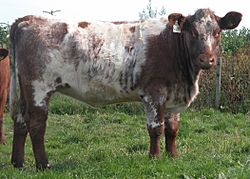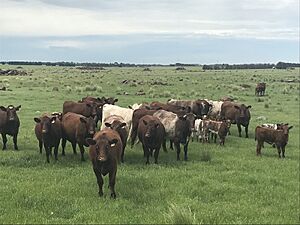Shorthorn facts for kids
The Shorthorn is a type of cattle that first appeared in the North East of England in the late 1700s. These cows were special because they could be used for two main things: producing milk (dairy) and providing meat (beef).
Over time, farmers started to focus on one quality more than the other. This led to two different types of Shorthorn cattle by the mid-1900s: the Beef Shorthorn (for meat) and the Milking Shorthorn (for milk).
Shorthorn cattle come in different colors: red, white, or a mix called roan. Roan cattle, which have a mix of red and white hairs, are often very popular. While most Shorthorns are colored, there is also a special type called the Whitebred Shorthorn. These cows are always white and were bred to mix with black Galloway cattle to create a popular blue roan crossbreed known as the Blue Grey.
Contents
History of Shorthorn Cattle
The Shorthorn breed grew from older types of cattle called Teeswater and Durham, found in North East England. In the late 1700s, two brothers, Charles and Robert Colling, began to improve the Durham cattle. They used special breeding methods, like those used by Robert Bakewell for Longhorn cattle, to make the cows even better.
In 1796, Charles Colling bred a very famous animal called the Durham Ox. A big moment in their breeding program was the birth of a bull named Comet in 1804. This bull was so special that he was sold for 1,000 guineas in 1810, which was a huge amount of money back then! It was the first time a bull had ever sold for such a high price. Some related cattle might have been brought to the United States before 1808 by Harry Dorsey Gough of Baltimore, Maryland.
At the same time, other breeders like Thomas Bates and John Booth were working on the Teeswater cattle. Bates focused on making cows that were good at producing milk. Booth, on the other hand, worked on cows that were good for meat. Some of Booth's cattle were taken to Scotland in 1817 and helped create the Beef Shorthorn breed.
In 1822, a man named George Coates created the first ever official record book for cattle. This book, called Coates's Herd Book, listed the family trees of Shorthorn cattle. After Coates, Henry Stafford took over publishing the book. Later, in 1874, the Shorthorn Society of Great Britain and Ireland bought the rights to the book and has continued to publish it ever since. In the United States, the American Shorthorn Herd Book was started in 1846, and the American Shorthorn Association was formed in 1872.
Where Shorthorns Live Today
Today, you can find Shorthorn cattle mostly in countries where English is spoken, and in parts of South America. The main countries where they live are: Argentina, Australia, Canada, New Zealand, the Republic of Ireland, South Africa, the United Kingdom, the United States of America, Uruguay, and Zimbabwe. In north-eastern England, the Beamish Museum helps keep the original Durham breed alive.
Shorthorns in Australia
Shorthorn cattle were among the first purebred cows brought to Australia. Several cows arrived in New South Wales in 1800. More purebred Shorthorns were imported in 1825 by Potter McQueen. Later, the Australian Agricultural Company also brought in more Shorthorns. In the 1930s, Thomas Simpson Hall, who bred the famous Halls Heeler dogs, imported Durham Shorthorns. He used these to create large herds of Poll Shorthorns, which are Shorthorns born without horns.
Because Shorthorns have a wide range of genes, several different but related types have developed over time. These include:
- Beef Shorthorn (for meat)
- Poll Shorthorn (without horns)
- Durham (the original type)
- Milking or Dairy Shorthorn (for milk)
- Australian Shorthorn
Today, the Shorthorn Society of Australia includes the Poll Shorthorn, Australian Shorthorn, and Durham types. Shorthorns have also helped create other cattle breeds like the Belmont Red and Santa Gertrudis.
Images for kids
See also
 In Spanish: Shorthorn para niños
In Spanish: Shorthorn para niños







